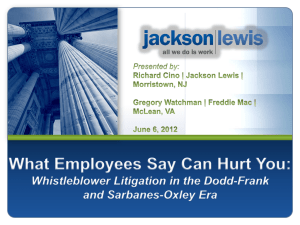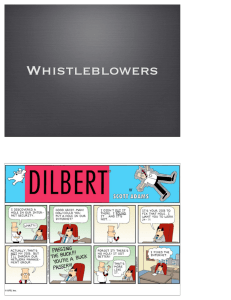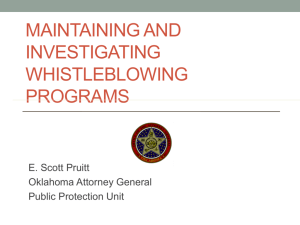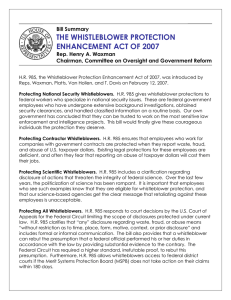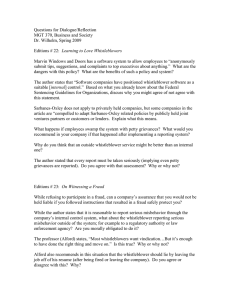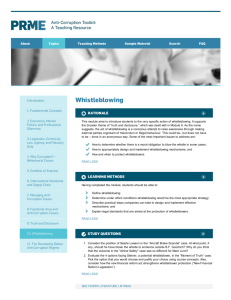Uploaded by
Bülent Turan Ödevleri
Whistleblower Stressors & Coping Strategies: A Survey
advertisement
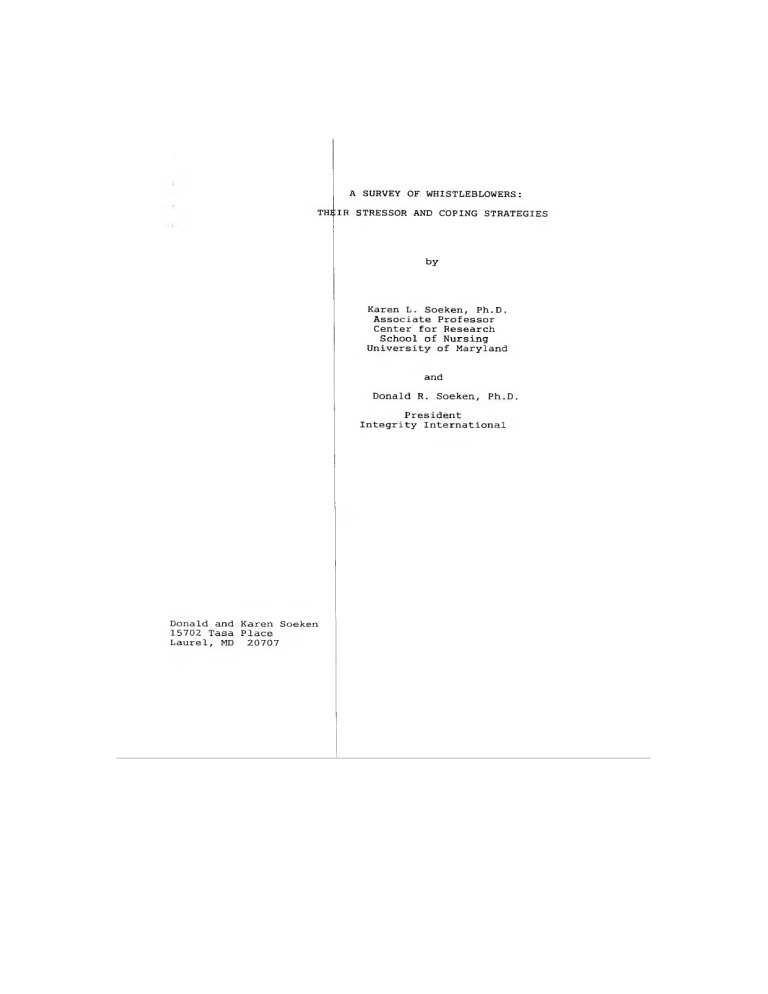
A SURVEY OF- WHISTLEBLOWERS; THEIR STRESSOR AND COPING STRATEGIES by Karen L. Soeken, Ph.D. Associate Professor Center for Research School of Nursing University of Maryland and Donald R. Soeken, Ph.D. President Integrity International Donald and Karen Soeken 15702 Tasa Place Laurel, MD 20707 Whistleblowing is a complex phenomenon occurring with greater frequency. that appears to be While much has been reported about individual whistlebLower cases, we sought to identify common experiences or effort assist to common claracteristics those who work of whistleblowers with and on in behalf an of whistleblowers. Many persons have helped to make this project successful. Our sincere thanks to those wlo helped us to gather names and addresses of whistleblowers, those who reviewed the questionnaire for completeness and clarity, Louis Clark for his encouragement, Cathy Haynes for typing the several versions of the survey form, and our daughter Beth for assistance encoding. in collating and mailing and data Most importantly we thank those whistleblowers who took time to participate in the; survey by sharing so much of themselves with us. We know that for many reliving their experiences was quite painful. Many also provided us with supporting documents and information; some thankee us for "caring enough to ask" for the information. To all of, you are to be commended and rewarded for your activity! Contained findings. in this document is a summary of our research We hope that it will lead to further understanding of the whistleblowing experience. A SURVEY OF WHISTLEBLOWERS: THEIR STRESSORS AND COPING STRATEGIES In an effort to understand whistleblowing experience, the commonalities of the questionnaires with cover letter and return postage were mailei to a sample of 233 whistleblowers in the Spring of 1986. Of that lumber, 15 were returned due to incorrect addresses, 2 declined to participate because of pending litigation, and 87 questionnaires were completed and returned. Three, however, were received too late to be included in the data analysis although the open-ended responses to items were included. The response rate, then, was 40%. The available sample represented individuals identified as whistleblowers in private industry and government. Names were gathered from a variety of sources, primarily whistleblower support groups and other whistleblowers. In the absence of any type of roster from which to sample, this nonprobability sampling method was used. Although the results of this survey come from a convenience sample, we do believe that the sample is representative of known whistleblowers. Those responding to the survey ranged in age from 28-72 years with a mean age of 47 years (SD , 10.3). were male. Twenty-five Almost two-thirds (73%) (30%) had been employed in the private sector with 57 (68%) employed by the government (49 Federal, 8 city or state). in the The respondents did not indicate whether they had been public whistleblowing, or private 44% were sector. At the time of the in professional positions and 24% held 3 managerial positions. positions/ professions Included such as in the sample attorney, were those physician, in nurse, engineer, electrician, secretary, truck driver, financial officer, and librarian. Ten respcndents (12%) were in the military at the time of blowing the whistle. For most (63%) the whistleblowing episode reported occurred after 1980. Overall, at the time of the whistleblowing, respondents tended to be between 39 and 43 years of age. Those in private industry, however, tended to be younger (33-40 years) as compared to those in government (40-45 years). They had been employed at the firm/agency for an average of 6.7 years prior to the whistleblowing. Almost three fourths (74%) had been there 10 years or less and one-third (32%) had been there two years or less. It appears that whistleblowing tends to occur when the employee has been at a firm/agency between 5 and 8 years. Over half reported exposing abuse (54%) followed by fraud (47%), waste (44%), corruption (41%), safety (16%), and other (5%). activities exposed varied and included violation of federal law, misuse of public funds, misuse of Federal excessive falsifying of documents, facilities, spending, and mismanagement, questionable research activities, censorship. They dealt with legal, technological, and personnel matters as well as environmental and safety issues. When asked to attach a dollar amount to the waste, fraud, or abuse exposed 36 respondents did so with 25 of the 36 indicating the amount exceeded $1 million. 4 How Did They Blow the Whistle? Over half (57%) reported blowing the whistle in person. remainder used the telephane (22%) or mail (22%). sample took, their action anonymously, The Only 21% of the (note: Because these individuals are in the sample, one can assume that at some point in the process the anonymity was broken. Those who managed to remain anonymous are not in the sample and represented by these results, of course.) Table 1 indicates to whom respondents first blew the Table 1. Reported To Whom the Was te, Fraud, Abuse or Corruption Was First Number To Whom Efemant Immediate supervis or 30 36.6 Head of firm/agenc y 14 17.1 Newspaper/Radio/Pr ess 11 13.4 Hot Line 6 7.3 Congressional Repr esentative 4 4.9 Government Account ability Project 1 1.2 16 19.5 Other whistle. It is interesting to note that over half (54%) approached someone within the firm/acency rather than going to the media or to Congress. General, Included EEO In officer, :he "other" Attorney category are the Inspector General, Nuclear Regulatory Commission or Secretary of State, all of whom could be considered internal routes as well: These 5 results are counter to those individuals who speculate that the whistleblower is motivated by a desire for publicity, choice of an internal versus whistleblowing Further, it although was did the not same vary the specific external for the route as a strategy for private based route varied, on and age public or sectors. gender of the whistleblower. For 80.5% of the sample, the initial action was considered unsuccessful and they subsequently used other avenues, primarily external routes. Most frequently whistleblowers turned to a congressional representative (20%), the press (12%), the next level supervisor (12%), or an attorney (12%). Others mentioned the Government Accountability Project, Office of Special Counsel, Civil Service Commission, OSHA of." the union, or "everyone I could think It's important to note that those who choose to 'go public' In whistleblowing have already tried working within the system and have found their efforts to be unsuccessful for the most part. Retaliation Experienced b v Whistleblowers All but one respondent reported experiencing retaliation which they attributed to their whistleblowing. That one merely indicated that "nothing could be proved." individual For the rest, however, retaliation occurred in several forms (Table 2) with those who had (r=-.19). harassment been employed Generally or longer the job-related. experiencing retaliation For can example, more be retaliation categorized harassment came as from superiors (82.1%) as well as from peers (53.6%) and included verbal 6 Table 2. Retaliation Experienced by Whistleblowers. Number Retaliation Harassment from superiors Monitoring of activities Removal of job responsibilities Loss of job Harassment from peers Change in type of position Monitoring of office telephone Demotion Legal action Psychiatric or medical referral Decrease in sal ary Forced retireme it Sexual harassme nt . 69 58 53 50 45 37 32 26 23 22 14 12 11 Percent 82.1 69.0 63.1 59.5 53.6 44.0 8.1 1.0 27.4 26.2 16.7 14.3 13.1 harassment and abuse, telephone and activity monitoring, denial of sick leave request, or teing ignored. Job-related retaliation included demotion, firing, and forced retirement. Some harassment differed between those in private industry and those in government. Whistleblowers in private industry were more likely to loose their jobs (84% private versus 49% government) while those in government were more likely to have job responsibilities removed (75% versus 40%), office telephone monitored (47% versus 16%), forced retirement (19% versus 0% I, or sexual harassment (18% versus 4%). Retaliation did not differ between males and females, nor did the extent of retaliation appear to be related to the age of the whistleblower. Younger employees, however,and those employed a shorter time prior to whistleblowing tended to experience loss of job and monitoring of acti.vities. 7 Resources Used bv the Whistleblower A variety of resources were used by whistleblowers to help) them to cope with the results of their activity (Table 3). Table 3. Most Resources Used by Whistleblowers Percent U sad Helpfulness Rating Resource 90 79 60 57 47 45 4 13 Legal advice Contact with other whistl eblowers Government Accountability Project Psychological Counseling Medical Consultation merit System Protection Board Office of Special Counsel (OSC) Project on Military Procu rement 2 2 2 2 1 0 0 1 5 8 7 1 6 2 9 1 3 4 5 0 6 6 8 2 0 = Not at all and 5 = very Helpful Note: sought legal advice and 63.1% indicated legal action of some sort while 20.2 had legal action brought against them. Contact with other whistleblowers, the Government Accountability Project (GAP), and psychological counseling were other resources used by over half of the respondents. helpful These same resources were, rated to be the most although it should be noted that they were still only moderate helpful according to respondents. (Note: Some of these resources are available only for Federal employees.) Effects of the Whistleblowing Episode The events surrounding the whistleblowing episode were considered very stressful for the whistleblower (mean rating 8.0 where 9 = Extremely Stressful) who felt only a moderate degree of control over what was happening. 8 Whistleblowers considered themselves to be in good physical whistleblowing and and mental as a result of the stress health prior to experienced both physical and mental health were reported to have deteriorated to the "modest" level. It would appear that the length of time involved in resolving the events surrounding the whistleblowing was a factor. For 37%, resolation took an average of 3 years; for the remaining 63%, resolution has not yet occurred despite the 5 years that have passed since the actual whistleblowing. The results and stressfulness of the whistleblowing not only affected the individual, but understandably affected the spouse and, to a lesser extent, the children also (Table 4) Table 4. The most Overall Effects of Whistleblowing on Self, Spouse, and Children Children Ef fec t Self Snouse + Non e 4.8* 15.7 79.6 5.1 32.2 62.7 5.9 45.1 49.0 Emotional State + Non - 8.4 6.0 85.5 5.1 9.5 85.4 2.0 29.4 68.6 Social Activities + Non “ 6.0 22.9 71.1 3.4 37.1 69.5 5.9 45.1 49.0 + Non B 37.8 17.1 45.1 18.6 33.9 47.5 5.9 52.9 41.2 Physical Health Spiritual Well-Being ^Percent reporting negative effect was on :he emotional 9 state followed by social activities and physical health. Even spiritual well-being was perceived as being somewhat negatively affected. (Note: Seventy percent of the whistleblowers were married at the time and 61% had children.) Table 5 spouse are powerlessness, provides a listing of what the whistleblower and reported anxiety, ;o have anger, experienced. isolation, and Feelings depression of were accompanied by changes in sleep, eating, and exercise patterns for both. Financial concerns resulting from loss of job. Table 5. Symptoms Reported by the Whistleblower for Self Spouse Symptom Increased alcohol use Increased drug use Increased smoking Lack of exercise Weight loss Weight increase Loss of sleep Increased sleep Feelings of panic Sense of powerlessness Loss of financial credit. Increased anxiety Increased anger Attempted suicide Psychosomatic illness Withdrawal Paranoia Depression Feelings of isolation Feelings of being misunde rstood Loss of financial indepen tence Soouse (n=59) 13.6 10.3 20.3 23.8 8.5 33.9 50.8 3.4 25.4 33.9 20.3 69.5 54.2 1.7 6.8 16.9 15.3 35.6 30.5 22.0 26.7 Self (n=841 26.S 18.1 24.1 54.2 28.9 37.3 77.1 13.3 50.6 81.9 44.6 80.7 79.5 9.6 22.9 45.8 34.9 73.5 73.5 71.1 54.2 and or forced retirement were common also. For some, the whistleblowing led to loss of home (17%) or bankruptcy (8%) and 15% view divorce to be a result. Almost 10% reported they had attempted suicide with others indicating they had considered it. Interestingly, thosa who experienced harassment from their peers for being a whistleblower reported significantly more stress connected with the episods. It would appear that a support network within the work environment is critical to minimizing the stress, whether or not the whistleblower attempted to be anonymous was another factor related tc the stressfulness. Dhose who attempted to be anonymous reported a higher level of stress, consistent with the increased extent of retaliation they experienced. Dhis finding would suggest that a mechanism for whistleblowing be developed that would protect the anonymity of those who desire it. Anonymity would serve also to decrease or eliminate the harassment from peers associated with the increised stress. When asked to list the three most negative outcomes of their whistleblowing, the financial burden and/or loss of job topped the list (54%). Cited second most often was the emotional strain on self (21%) or family (19%), (17%). along with the ridicule from others Loss of promotion or career change was listed by 17%. Included in this latter group are a number of whistleblowers from the nuclear power industry who indicated they were blackballed from the industry as retaliation. Some mentioned having lost faith in other (7%), the government (6%), or the judicial system (5%). even reported having action taken against their lives. 11 Two Wavs of Coping Coping consists of cognitive and behavioral efforts to overcome, reduce, or toltirate the internal and environmental demands in stressful situations. The revised Ways of Coping scale was used to determine the strategies whistleblowers used to cope. The items coping. measure prob Lem-focused coping and emotion-focused, Problem-focused coping refers to efforts to deal with the source of stress by changing on e 's own behavior and/or by changing environmental conditions. Emotion-focused coping refers to efforts to reduce or tolerate emotional distress. In general, adults tend to use relatively more problem-focused coping in work situations and those situations they believe they can change situations and to and ones use more the/ emotion-focused appraise they must coping in accept. health Coping flexibility involves using a variety of coping strategies over time with confrontive, denial, and escape/avoidance techniques generally leading to poor outcomes if used excessively. Among this emotion-focused sample pf strategics whistleblowers, problem-focused were approximately used amounts, suggesting flexibility. in and equal Although they tended to confront the situation rather than distance themselves from it, they also used positive strategy reappraisal and relatively most used exercise of frequently self-control. was to seek J,he social support. The length of time employed at the firm/agency prior to whistleblowing was not associated with coping although age was. 12 Younger workers tended tp be more likely to accept responsibility, attempt to distance themselves, and use escape/avoidance strategies. What Motivates the Whistjleblower A number of personal ity and environmental factors undoubtedly interact to motivate the whistleblower to action. Specifically measured in this survey was the ethical Ideology. The Ethics Position Questionnaire two factors. The measures approaches to moral judgment using first, is the extent to which an rejects universal moral rules in favor of relativism. dimension is the degree of idealism. individual The second Based on these two factors, individuals are categorised as adopting one of four approaches to making ethical judgments: situationism, absolutism, subjectivism, and exceptionism. Whistleblowers surveyed tended to be In two of the four groups (Table 6). Table 6. Generally, those Ethical Ideologies of respondents Relativism Idealism Hiah Low High Situationists 10.8% Absolutists 45.9% Low Subj ectivists 9.5% Exceptionists 33.8% responding believe moral codes are universal rather than relative. For the absolutists, acts are judged as moral through comparison to 13 the universal moral rule. They believe that the best possible outcome can always be achieved by following universal moral rules. Exceptionists, however, believe that absolute moral principles are important but the rules mist be applied in a way that produces the greatest good for the greatest number. As might be expected, situationists tended to be the younger whistleblowers. Would They Blow the Whistle Again? Xn spite of the retaliation experienced and the stress which resulted, when queried as to how likely they would be to blow the whistle again, only 16% responded "not at all" as compared to 54% who responded "extremely likely." the remainder were evenly divided between being like and unlikely. The likelihood was somewhat less for those who experienced harassment from peers, legal action, and change in the type of employment position. Increased likelihood was related also to the increased use of problem-focused coping strategies. Furthermore, likelihood was unrelated to factors such as ethical ideology, age, length of time employed, how stressful the situation was perceived to be, or whether the individual was in the private sector. One factor which was associated with the likelihood of blowing the whistle again was telephone monitoring with a record kept of all numbers significantly called. less Respondents likeLy to blow indicated the they whistle would under be these conditions and perceived Lt very likely that the information from monitoring would be usee, against 14 them. In this increasingly technological environment, such monitoring could impact on whistleblowing in the future. Positive Results of Whistleblowing Did anything positive occur as a result of the whistlelowing? Only 20% indicated that changes were made as a result of their activity. Many management of the change, 20% cited personnel personnel practices changes: complete corrected, persons transferred or replaced o:: not reappointed, department restructed. Others cited changes in policy, indictments, improved safety, or official investigations b/ the FBI or NRC. mentioned a personally, positive outcome from Almost all respondents the experience for them however, mentioned by 34% was an increased sense of self-respect or self-wortr for having done what was right. Almost an equal number (32%) mentioned having made the workplace healthier or safer or having saved the taxpayers money. For some the event provided an opportunity to make new friends (11%), grow in the spiritual dimension (11%), further define their values (8%), or increase their commitment to family (5%). Several (11%), mentioned a career change or getting out of the government as a positive outcome. Advice to Potential Whistleblowers Don't do it! of the That ac.vice was offered by almost a third (29%) respondents. They also warned to and mental anguish (45%). expect retaliation, financial loss, That advice must be tempered, though by advice to listen to your conscience (20%), document everything (31%), get support from other whistleblowers 15 (14%), know your legal rights (14%), plan your actions carefully (12%), and do it anonymously or get someone else to do it for you (13%). Those in the survey seem to be telling others to be aware of the consequences and then do what is right for them, availing themselves of whatever support systems are available. References 1. Folkman, S. and Lazarus, R.S. (1980). community sample. Journal Coping in a middle-aged of Health and Social Behavior. 2 1 . 219-239. 2. Forsyth, Journal of D.R. (1980). A taxonomy of ethical ideologies. Personality and Social Psychology. 39(1), 175-184.
